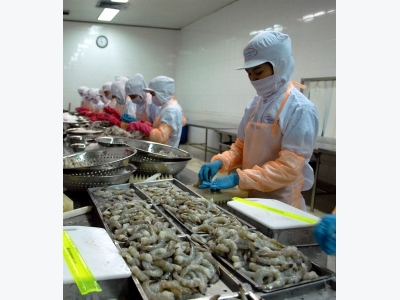VN shrimp brand: difficult, but not too late

Việt Nam is the third largest shrimp producer and the largest giant tiger prawn producer in the world. Shrimp is a major export item, but it lacks brand value. Đào Đức Huấn explains why. The director of the Agricultural Development Centre also tells Vietnam News Agency it is not too late to build a national brand for Vietnamese shrimp in the global market.
Vietnamese shrimp products have been exported to 90 markets worldwide. Recent years have seen high growth in shrimp exports. Does Vietnamese shrimp have brand identification in the world market?
In 2016, Việt Nam earned US$3.1 billion from shrimp exports, overtaking Thailand as the world’s largest shrimp exporter. Major shrimp export markets included the US, the EU and Japan.
Exported shrimp products do have some brand value, but it is limited to importers and distributors, not customers.
Brand is more than a popularity marker, it denotes customers’ confidence in the brand name, hence its products. It is a word or words that not only identify a product, but also its manufacturer. It displays the origin and quality of products in the market.
Is too late to discuss the building of a national brand name for Vietnamese shrimp products at present?
Many factors go into building a brand name, including the ability to control production to reach quality and other standards that the market demands.
In Việt Nam, the development of shrimp aquaculture over past years has helped enterprises learn their production abilities and product advantages.
Another factor is processing ability and market expansion, especially development of products joining global value chains.
These abilities require enterprises to reach certain benchmarks in finance, human resources and technology, and to have the determination to enter and survive in the global market.
A brand for Vietnamese shrimp will only be meaningful when our products go to consumers with clear identification and quality assurance, our supply is stable and we have won customers’ confidence.
So, it is late, but not too late to build a brand for Vietnamese shrimp. The conditions and opportunities still exist.
What is the most difficult thing about building a brand name for Vietnamese shrimp now?
The most difficult thing would be to build an image for "Product of Việt Nam," setting a "standard" for the brand.
Việt Nam produces many kinds of shrimp, including as white shrimp, black tiger prawn and sea shrimp. These have been exported to many markets in the world.
Now, the nation must choose general standards in quality, nutrition and food safety and other commercial standards to build a brand for Vietnamese shrimp.
This is the biggest challenge, as with other agricultural products, because major export markets like the EU, US and Japan have different processing methods, tastes and controls. Our general standards for Vietnamese shrimp should meet demands in all export markets.
Secondly, production control, including varieties, diseases and environment, is still a big challenge in shrimp aquaculture. Production costs are high, and it carries high risk without the capacity to control diseases and other variables. So regularising all of this is a challenge when we try to build a brand for Vietnamese shrimp.
The third factor is the perseverance, determination and co-operation among all stakeholders, including farmers, processing facilities and trading enterprises in building the brand.
We have seen that for many farming products, enterprises have focused on domestic rather than foreign competition. They can sell their products, but a failure to build and maintain standards will reduce the reputation of both local products and the nation.
What about the variety factor?
In Việt Nam, parent shrimp are provided by nature or they are imported. The quality of parent shrimp is still unstable though the Government has investment to development of parent shrimp.
We are yet to use modern methods in choosing, producing and supplying shrimp varieties. Our production costs remain high and the aquaculture infrastructure in several regions has not reached required standards.
Việt Nam has 2,422 farms producing brackish water shrimp, supplying 100 billion shrimp varieties each year but the supply has only partly met domestic demand at present.
Meanwhile, the markets receive and supply varieties without proper origin and quarantine processes. This has exposed farmers to many production risks.
For instance, the Government has had to look for ways to stop the practice of injecting impurities into shrimp, harming the reputation of Vietnamese seafood.
The Ministry of Agriculture and Rural Development plans to improve its management and policies to promote production and processing of quality seafood, including shrimp.
What should the agriculture sector do to reach the shrimp export target of US$10 billion by 2025?
The agriculture sector should restructure shrimp aquaculture areas according to natural conditions and advantages of each region, and expand cultivation in areas while taking steps to avoid or minimise the risk of diseases and other harmful factors. The sector has to apply scientific and technological advancements in shrimp production, including disease control.
The shrimp industry should also improve product value by controlling quality and production processes to meet the requirements of demanding markets. It should also develop safe and environmentally-friendly shrimp, as also value-added products.
Related news
Tools

Phối trộn thức ăn chăn nuôi

Pha dung dịch thủy canh

Định mức cho tôm ăn

Phối trộn phân bón NPK

Xác định tỷ lệ tôm sống

Chuyển đổi đơn vị phân bón

Xác định công suất sục khí

Chuyển đổi đơn vị tôm

Tính diện tích nhà kính

Tính thể tích ao



 Mekong Delta farmers start first shrimp harvest season
Mekong Delta farmers start first shrimp harvest season  Fishery output exceeds 1 million tonnes in four…
Fishery output exceeds 1 million tonnes in four…